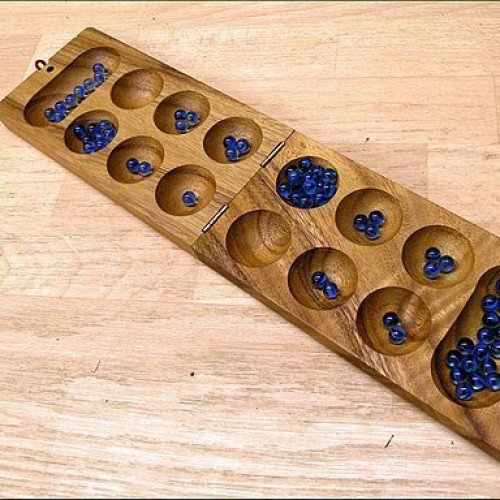KALAH VS SECTOR 41

KALAH
Kalah, also called Kalaha or Mancala, is a game in the mancala family invented in the United States by William Julius Champion, Jr. in 1940. This game is sometimes also called "Kalahari", possibly by false etymology from the Kalahari desert in Namibia. As the most popular and commercially available variant of mancala in the West, Kalah is also sometimes referred to as Warri or Awari, although those names more properly refer to the game Oware. For most of its variations, Kalah is a solved game with a first-player win if both players play perfect games. The Pie rule can be used to balance the first-player's advantage. Mark Rawlings has written a computer program to extensively analyze both the "standard" version of Kalah and the "empty capture" version, which is the primary variant. The analysis was made possible by the creation of the largest endgame databases ever made for Kalah. They include the perfect play result of all 38,902,940,896 positions with 34 or fewer seeds. In 2015, for the first time ever, each of the initial moves for the standard version of Kalah(6,4) and Kalah(6,5) have been quantified: Kalah(6,4) is a proven win by 8 for the first player and Kalah(6,5) is a proven win by 10 for the first player. In addition, Kalah(6,6) with the standard rules has been proven to be at least a win by 4. Further analysis of Kalah(6,6) with the standard rules is ongoing. For the "empty capture" version, Geoffrey Irving and Jeroen Donkers (2000) proved that Kalah(6,4) is a win by 10 for the first player with perfect play, and Kalah(6,5) is a win by 12 for the first player with perfect play. Anders Carstensen (2011) proved that Kalah(6,6) was a win for the first player. Mark Rawlings (2015) has extended these "empty capture" results by fully quantifying the initial moves for Kalah(6,4), Kalah(6,5), and Kalah(6,6). With searches totaling 106 days and over 55 trillion nodes, he has proven that Kalah(6,6) is a win by 2 for the first player with perfect play. This was a surprising result, given that the "4-seed" and "5-seed" variations are wins by 10 and 12, respectively. Kalah(6,6) is extremely deep and complex when compared to the 4-seed and 5-seed variations, which can now be solved in a fraction of a second and less than a minute, respectively.
Statistics for this Xoptio

SECTOR 41
Sector 41 is a board game published by David Long and Michael Lachtanski of Scimitar Games. The game became available for pre-order in February 2009 and was officially released in April 2009. Sector 41 is a turn-based strategy game for two to four players. Game play takes place on a 9×9 grid of face-down tiles, randomly shuffled at the beginning of each game. Players control one mother ship which moves along the edge of the game board. Mother ships can deploy up to three explorer ships onto the face-down grid. Explorer ships are used to discover, mine, and tow deposits of Glynium to their mother ship. According to the game background, Glynium is an unstable power source only found in this sector. Victory is achieved when one player has mined more Glynium than any other player could match. In the case of a tie, the first person to reach that score is declared the victor. Sector 41 was developed from a compilation of game concepts developed by David Long and Michael Lachtanski, the earliest of which go back to the mid-1990s. The name itself is an homage to the popular Area 51 science fiction theme. Play testing began in late 2007 and lasted until production began in late fall of 2008. The face-down tile set up was conceived of to emulate the fog of war mechanism, popular in many computer games. The developers also encourage players to strategically manipulate the board layout for offensive and defensive purposes through the process of "folding space". This game mechanism was inspired by the Dune novels. The lengthy play time in the initial play testing lead developers to create the Guardian figure. The Guardian, described below, acts as a mechanism for rewarding exploration, expansion, and reduced play time dramatically. Additional rules for modifying the Guardian's role in gameplay are available on the Scimitar Games website. Michael Lachtanski designed the game's graphics. Many of the space graphics are based on images from NASA.